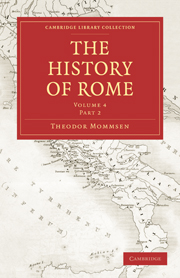CHAPTER XI - THE OLD REPUBLIC AND THE NEW MONARCHY
Published online by Cambridge University Press: 07 September 2010
Summary
Character of Cæsar
The new monarch of Rome, the first ruler of the whole domain of Romano-Hellenic civilisation, Gaius Julius Cæsar, was in his fifty-sixth year (born 12 July 652?) when the battle of Thapsus, the last link in a long chain of momentous victories, placed the decision of the future of the world in his hands. Pew men have had their elasticity so thoroughly put to the proof as Cæsar—the sole creative genius produced by Rome, and the last produced by the ancient world, which accordingly moved on in the track that he marked out for it until its sun had set. Sprung from one of the oldest noble families of Latium—which traced back its lineage to the heroes of the Iliad and the kings of Rome, and in fact to the Venus-Aphrodite common to both nations—he spent the years of his boyhood and early manhood as the genteel youth of that epoch were wont to spend them. He had tasted the sweetness as well as the bitterness of the cup of fashionable life, had recited and declaimed, had practised literature and made verses in his idle hours, had prosecuted love-intrigues of every sort, and got himself initiated into all the mysteries of shaving, curls, and ruffles pertaining to the toilette-wisdom of the day, as well as into the far more mysterious art of always borrowing and never paying. But the flexible steel of that nature was proof against even these dissipated and nighty courses; Cæsar retained both his bodily vigour and his elasticity of mind and heart unimpaired.
- Type
- Chapter
- Information
- The History of Rome , pp. 450 - 558Publisher: Cambridge University PressPrint publication year: 2010First published in: 1866



